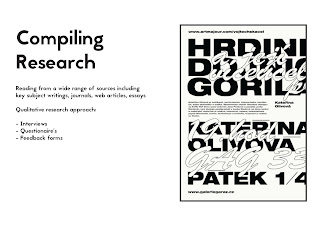Structuring of Essay
In order to execute my dissertation successfully, I will need to follow some sort of logical structure/essay plan. The theme in which I am tackling is fairly broad, however I do have specific interests within the overarching theme/question.
I am interested into examining the concept of order or chaos within visual communication and graphic design. Ultimately, I will exploring the extend to which deconstructionist theory has impacted/influenced contemporary visual culture in a literal or abstract sense. I have devised a rough outline of the structure in which I see the essay tacking:
Intro (1000 Words)
Introduce the theme in an
articulated manner
Outline the chapters and the
aim of the investigation
Introduce key texts and
writers in the field/topic
Chapter 1:
Origins - The Origins of Deconstructivism
I will briefly explore the
concept that high modernism imposed mass order through its philosophy and
postmodernism’s reaction to this order in the form of visual profusion,
subversion and chaos – how the emergence of postmodernism and deconstructivism
was inevitable – discuss how this was potentially the last truly definable
‘movement’ with ‘graphic design’ and how we have arrived at a time of
uncertainty and intangibility presently.
Discuss how deconstructivist
style emerged within visual communication from Postmodernist and
Post-structuralist theory/ideology – What was it a reaction to? How was it
received? What were its aims and intentions? Why did it emerge? What are its
earliest roots? (Dadaism)
Summaries the totalitarianism
of modernism and why it was inevitable that creative people would question its
authority.
Here I will explore key
theorists in a bit more detail: Derrida, Lupton, Baudrillard, Jameson, Barthes,
Poyner critiquing and contrasting their views
Chapter 2:
Lasting Impact/Influence - The Influence of Deconstructivism on Contemporary Visual Culture
This chapter will explore several
designers/practitioners that pioneered the deconstructivist movement within
visual communication, examining the contexts that they worked within and why
they did what they did. Here I will explore the impact of changes in technology
and global culture and how these changes sped up the rise of postmodernism and
deconstructivist aesthetic.
I will look at a range of practitioners
who were active in the 80s and 90s: Jamie
Reid, Kathrine McCoy from The Cranbrook Academy, David Carson, Neville Brody.
I will then move on to look at
the lasting impact that these key creatives have had, examining the
underpinning influence of deconstructivist ideology/theory has had, whether that
be conscious of unconscious influence
The freedom of expression and
fluidity that this small movement has facilitated is larger than most people
like the believe.
I want to examine the relevance
of deconstructivism within contemporary design culture. Is it offering anything
productive or positive? Here, I will discuss at least three key pieces of
contemporary graphic design that I feel are directly influenced by
deconstructivism, attempting to understand the inspiration behind the work, its
purpose and the reasoning behind the overall process and design treatment.
Chapter 3:
The Present - Is It Possible To Define Contemporary Graphic Design?
Here, I want to discuss the
concept of post-postmodernism or meta-modernism and how it can be applied to
understand current trends in visual culture. I am interested in the emergence
of the New Aesthetic and how this questions postmodernism and modernism
simultaneously.
Conclusion
Reflect on the key points raised and conclude whether or not I believe deconstructivist style has had a positive or negative impact on the way graphic design practice/culture is behaving currently.















